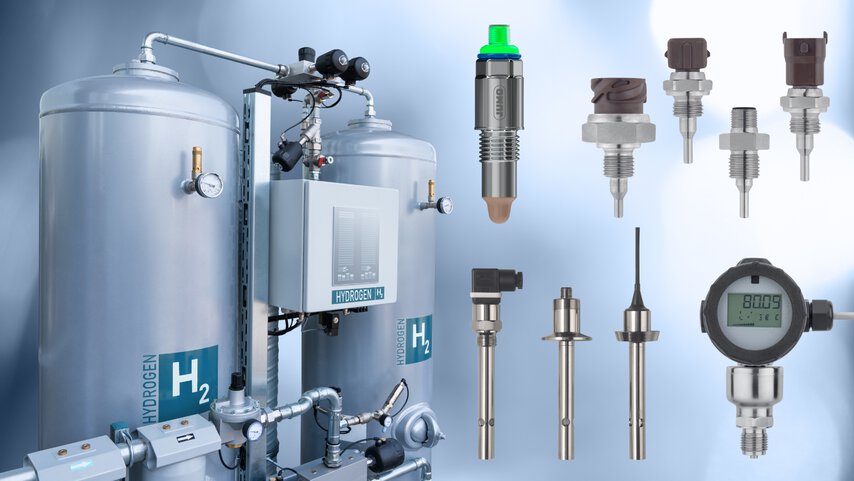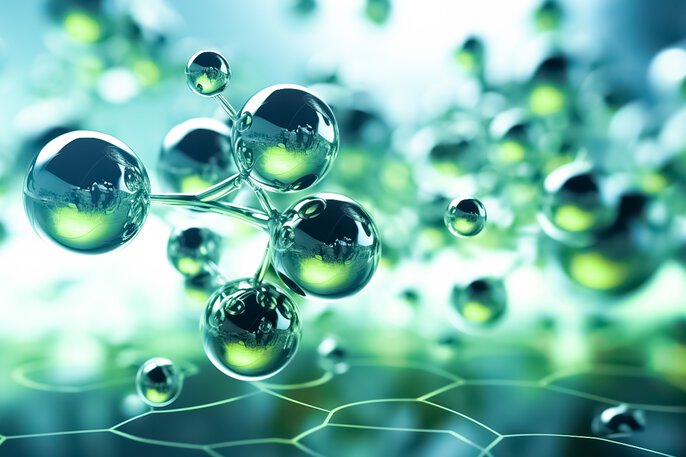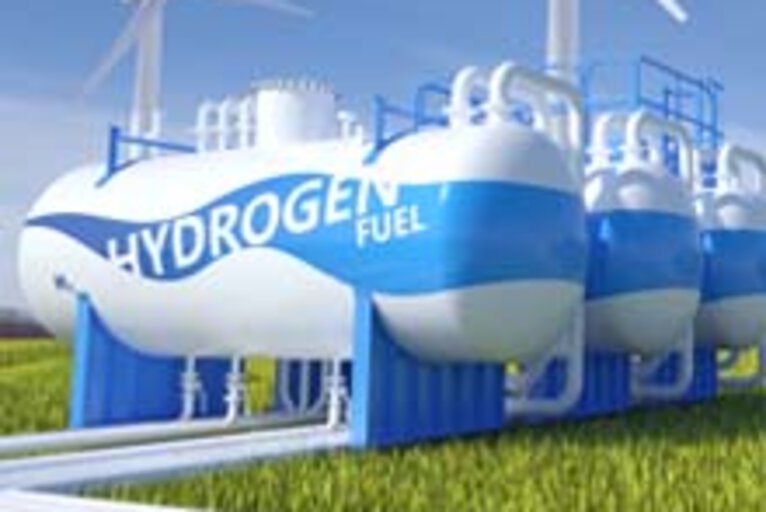

Hydrogen electrolyzer - temperature, pressure, conductivity, level and flow measurements
Green hydrogen, produced using renewable energy sources, is gaining importance as a potential fuel of the future. In this blog post, we'll look at its production and importance in achieving climate neutrality, as well as the applications of electrolyzers in hydrogen production. We will also learn about various aspects of safety, efficiency and control in electrolyzers, including monitoring of temperature, pressure, conductivity, flow and liquid level. In addition, we will discuss control and regulation in electrolyzers using thyristor power controllers and modular controllers. If you want to learn more about measuring devices and automation systems for green hydrogen production, read this article!
Green Hydrogen – A Key Element of Energy Transformation
Hydrogen, the most abundant chemical element, is considered a future energy source. Colorless, odorless, and non-toxic in its pure form, it can be used in an environmentally friendly way, offering a promising alternative to traditional energy sources. Green hydrogen plays a special role in supporting decarbonization efforts. It is climate-neutral, produced using renewable energy sources (RES) such as solar, wind, or hydro energy.
Green hydrogen has the potential to revolutionize many sectors, replacing fossil fuels in transportation, industry, heating systems, and energy production. Moreover, it offers a solution to one of the key challenges of energy transformation: the storage of excess energy generated by renewable sources. This opens the door for further development and implementation of innovative technologies, including fuel cells and electrolyzers, which could be groundbreaking for the future of sustainable energy.
Green Hydrogen as a Pillar of the European Strategy for Achieving Climate Neutrality
In the European context, green hydrogen has become a key element of the energy strategy aimed at achieving climate neutrality by 2050. The European Union has set ambitious goals, aiming to increase green hydrogen production capacity from the current 1 GW to 48 GW by 2030. This increase is crucial for the energy transformation in Europe, reflecting global aspirations for sustainable development and the need to switch to more ecological energy sources.

Green hydrogen is produced in a climate-neutral way using renewable energy
Electrolyzer – The Heart of Green Hydrogen Production
An electrolyzer is a device that uses electrical energy to split water into hydrogen and oxygen.
- Water is subjected to electric current, causing the splitting of H2O molecules into hydrogen (H2) and oxygen (O2) molecules.
- Hydrogen is stored, while oxygen can be used for other purposes.
This process allows for the production of pure hydrogen, which is then stored and transported for further use.
Applications of electrolyzers in brief:
Hydrogen production:
- Green hydrogen from RES, e.g., powering public transport, production of synthetic fertilizers
- In the chemical industry
- In refineries
Energy storage:
- Hydrogen as an energy store, e.g., storing surplus energy from photovoltaic panels
- Powering fuel cells
Other applications:
- Water treatment
- Metallurgical industry
- Medicine, e.g., inhalations for asthma treatment

Water electrolyzer produces pure hydrogen by splitting H2O molecules
The Importance of Temperature Measurement in Different Zones of an Electrolyzer
Temperature has a direct impact on the performance of an electrolyzer, as well as on its durability and safety. Too high a temperature can lead to faster wear of components and reduced efficiency, while too low a temperature can decrease hydrogen production efficiency. We offer a wide range of devices for measuring temperature in electrolyzers, including:
- VIBROtemp temperature sensors: Compact and vibration-resistant sensors for measuring temperature in different zones of the electrolyzer. Their short response time is ideal for monitoring dynamic temperature changes.
- Mineral-insulated thermocouples: Especially recommended for monitoring high temperatures, such as in Solid Oxide Electrolysis Cell (SOEC) processes, where process temperatures can reach up to 1200°C.
Typical applications of these devices in electrolyzers include monitoring the temperature of gaseous hydrogen and the temperature of the electrolyzer stack.
Safety Monitoring in Electrolyzers (up to SIL 3): Safe Temperature Limiter
Temperature is a key safety parameter in electrolyzers. The safetyM STB/STW Ex temperature limiter provides a high level of safety and precision. The device meets SIL 3 standard, is available in an Ex version for explosion-hazardous areas, and offers a wide measuring range from -50°C to +500°C. Additionally, it features safety functions such as self-tests and redundancy, and is easy to install and operate.

Vibration-resistant temperature sensors VIBROtemp (902040)
Pressure Measurement in Electrolyzers
Monitoring pressure in various parts of the electrolyzer, such as the water supply system and chambers where the electrolysis process occurs, is essential for maintaining a stable and safe hydrogen production process. High or low pressure indicates potential problems, such as leaks, blockages, or inefficient system operation, which can lead to failures or downtime.
- Universal Pressure Transducer MIDAS S05: This versatile pressure measurement device is suitable for use with both gases and liquids. It has compact dimensions, a robust casing, and provides long-term stability.
- Process Pressure Transducer dTRANS p20: Designed for industrial applications, including hydrogen. It has SIL2 (up to 100 bar) and ATEX certifications.
Both devices are excellent for monitoring the pressure of purified water supplied to the electrolyzer.

Industrial pressure transmitters MIDAS S05 (401010)
Conductivity Measurement in an Electrolyzer
Conductivity measurements are essential in the electrolysis process for monitoring the quality of water used in electrolyzers. Water with high conductivity can cause excessive corrosion and damage to electrodes, while water with low conductivity can decrease the efficiency of the electrolysis process.
Devices that are effective in this role include:
- digiLINE CR ST10 Conductivity Transmitter: Equipped with communication interfaces for automation systems such as JUMO digiLINE IO-Link. It also has integrated data memory and digital sensor management, which facilitates monitoring and data analysis.
- tecLINE CR Conductivity Sensor: This device offers conductivity measurement in a wide range – from very low to high values. It can operate at high temperatures, which is important in various industrial applications, including the electrolysis process.
Typical application of these devices is conductivity measurements at the inlet of purified water into the electrolyzer. They monitor the water quality, ensuring that it is in the right condition for effective electrolysis.

Conductivity digital transducer digiLine CR ST10 (202762)
Gas and Liquid Flow Measurement in Electrolyzers
Precise flow measurements are essential for controlling and regulating the amount of water supplied to the electrolyzer, directly affecting the efficiency of the electrolysis process. Inadequate water flow can lead to insufficient cooling of the system, which in turn may result in overheating and potential damage to the electrolyzer. Furthermore, flow control allows for the optimization of energy use, minimizing losses and increasing the overall efficiency of the system.
FlowTRANS US W02 is an ultrasonic flow meter that is an excellent example of a device used in monitoring flow in electrolyzers. It is characterized by its easy installation, corrosion resistance, and low consumption, making it an ideal solution for hydrogen environments. One of the typical applications of this flow meter in an electrolyzer is to monitor the flow and temperature of purified water at the inlet.

Ultrasonic flowmeter flowTRANS US W02 (406051)
Liquid Level Measurement in Electrolyzer Tanks
Accurate monitoring of liquid levels, especially water in tanks, ensures the continuity of hydrogen production process and is key to preventing system downtime or overload. An improper level of liquid can lead to inefficient operation of the electrolyzer or even to its damage, making level control an indispensable part of the operational process. Monitoring the water level in the tank also helps maintain the optimal amount of water needed for electrolysis.
- JUMO NESOS R0x LS Float Switch: This is a device designed to monitor the level of ultra-pure water and cooling media. It is characterized by its small dimensions, which facilitates easy installation. The possibility of external mounting with a G3/4 connection makes it very practical to use.
- ZELOS C01 LS Capacitive Limit Level Indicator: Its reliable and robust industrial construction along with an IO-Link interface make it an excellent solution for use in electrolyzers.

Float switches from the NESOS series
Humidity Measurement in Electrolyzers
Humidity measurement plays an important role in the electrolysis process, particularly in terms of quality control of the produced hydrogen and the protection of system components. High humidity in output gases, such as hydrogen, can affect the purity of the final product as well as the efficiency and safety of the process. Excessive moisture can also lead to corrosion and other damage to the components of the electrolysis system. Our specialized humidity and temperature transducers can be used for this purpose.

Humidity and temperature sensor for industrial applications (907023)
Control in Electrolyzers – Thyristor Power Controllers and Modular Controllers
Effective control in electrolysis, key to the stability and efficiency of the process, relies on power regulation. For this purpose, thyristor power controllers and modular controllers are used, which provide precise control of electrical energy. Thyristor power controllers, such as the TYA s202, offer precise control and easy configuration, while modular controllers, like meroTRON, enable management of complex process parameters. Their application in electrolyzers, particularly for temperature control and optimizing energy flow, significantly impacts the quality of the produced hydrogen and the durability of the system.
About the author
My name is Ewelina Szmit and I have been working in the field of content marketing for several years, combining my professional skills with my passion for writing. I believe that even the most technical topics can be presented in an interesting and accessible way for everyone. Outside of work, I develop my creativity by creating newspaper collages. I like to spend my free time most actively, walking my dog or running.

Technical specialist
Katarzyna Tracz - Inside Sales Engineer +48 71 339 32 86 Katarzyna.Tracz@JUMO.net +48 71 339 32 86Comments
We encourage you to leave your comments via the form below. They will be posted online after they have been approved through our review process.

